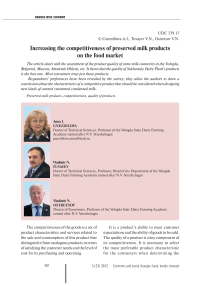Increasing the competitiveness of preserved milk products on the food market
Автор: Gnezdilova Anna Ivanovna, Tuvayev Vladimir Nikolayevich, Ostretsov Vladimir Nikolayevich
Журнал: Economic and Social Changes: Facts, Trends, Forecast @volnc-esc-en
Рубрика: Branch-wise economy
Статья в выпуске: 5 (23) т.5, 2012 года.
Бесплатный доступ
The article deals with the assessment of the product quality of some milk canneries in the Vologda, Belgorod, Moscow, Smolensk Oblasts, etc. It shows that the quality of Sukhonsky Dairy Plant's products is the best one. Most consumers trust just these products. Respondents' preferences have been revealed by the survey; they allow the authors to draw a conclusion about the characteristics of a competitive product that should be considered when designing new kinds of canned sweetened condensed milk.
Preserved milk products, competitiveness, quality of products
Короткий адрес: https://sciup.org/147223400
IDR: 147223400 | УДК: 339.13
Текст научной статьи Increasing the competitiveness of preserved milk products on the food market
Vladimir N.
TUVAYEV
Vladimir N.
OSTRETSOV
The competitiveness of the goods is a set of product characteristics and services related to the sale and consumption of this product that distinguish it from analogous products in terms of satisfying the customer needs and the level of cost for its purchasing and operating.
It is a product’s ability to meet customer expectations and the ability of goods to be sold. The quality of a product is a key component of its competitiveness. It is necessary to select the most preferable product characteristic for the consumers when determining the quality of products. Quality consists of many components. First of all, they include the technical and economic parameters of product quality, quality of its manufacturing technology and servicing characteristics, as well as indices of reliability and durability, labour input, material capacity and science linkage. Such properties and characteristics of products as environmental, ergonomic and aesthetic features are becoming more important today.
This research is aimed at studying the competitiveness of canned condensed sweetened milk and milk-containing products on the food market in Vologda.
Production of canned milk is continuously growing in the world [2, 6, 7]. There was an increase in the production amount of canned milk in Russia during the period from 2007 till 2009, but the production almost stabilized in 2010 and there was a slight decline, which amounted to -0.3% in 2009 [1, 3]. However, the main problem here is a tendency to the deterioration of canned milk quality. National Association for Genetic Safety has inspected the quality of condensed milk in the Russian retail stores and found that 80% of these products do not meet quality standards [5]. According to surveys, almost 85% of the people, who bought canned milk at least one time per the last two years, faced the problem of poor quality. Today, the information on State Standard on the label of the product, according to which this product is made, does not exclude the risk of purchasing low quality products.
Recently, the development of the dairy industry in the country and in the world is characterized by the tendency to increase the production of sweetened condensed milk through a new technology of mixing the components (dried unskimmed and skim milk, dry whey, etc.) with the partial replacement of milk fat in vegetable oils [4]. This trend is primarily caused by a lack of raw milk, its high cost and producers desire to reduce the cost of final goods.
The advantage of a new technology is its ability to expand a range of products; it allows the producers to exclude the seasonality of production, install energy-intensive expensive equipment (vacuum evaporators) and reduce the production areas.
In our region canned condensed milk is produced by Sukhonsky Dairy Plant and Kaduysky Dairy Plant. The volume of their production amounted to 14.5 thousand tubes in 2011. The part of canned condensed milk produced by these enterprises is exported. As a result, only 88% of the regional population’s demand for canned condensed milk is met. Therefore, today the Vologda market is full of canned condensed milk with sugar produced in other regions such as the Belgorod Oblast, the Moscow Oblast, the Smolensk Oblast, Belarus, etc.
We have assessed the production quality of the dairy plants of these regions in comparison with the products of Sukhonsky Dairy Plant that is located in the Vologda Oblast. Physical and chemical parameters that largely determine the quality of the final products have been used as evaluation criteria in accordance with the State Standard R53436-2009. The results of analyzes are presented in the table.
There was fat and crystals sediment in condensed milk produced by Alekseyevsky and Gagarinsky dairy plants, which was caused by the lower viscosity of products.
The products of Voskresensky Dairy Plant were characterized by caramel flavor and black discoloration. In addition, the products had increased viscosity.
The products of Rudnyansky and Voskresensky dairy plants had mealy texture caused by the presence of crystals that were larger than 10 – 15 microns. The share of these crystals was more than 20%.
However, it was found that the primary defect in quality is insufficient product texture due to the presence of large lactose crystals. This fact indicates the procedural violations
Physical and chemical quality parameters for canned sweetened condensed milk of various plants
The products of Sukhonsky Dairy Plant had the best physico-chemical and organoleptic qualities. It is this product that is in great demand among the consumers.
At present, the producers are going to expand a range of foodstuffs that are balanced in terms of nutritional value and affordable for the consumer. In order to develop the products that can meet the customer needs and find a ready market, they have been studied through a questionnaire.
The main factors affecting the demand, as it is known, are:
-
• consumers’ incomes;
-
• consumers’ tastes and preferences;
-
• prices for substitutional and complementary products;
-
• consumers’ stocks of goods (consumer expectations);
-
• information about product;
-
• the time spent on consumption.
According to the above-mentioned factors, the questionnaire was developed. 100 people of all ages were interviewed during the survey. The age structure of respondents is shown in figure 1 .
The main respondents included people at the age from 38 to 45. All respondents have a positive attitude to the enrichment of foods with vitamins and prefer them as a source of natural products rather than ready-made pre-mixes (fig. 2) .
Most potential buyers (89%) have a negative attitude to the products containing natural colouring agents and flavours; they prefer a clean milk flavour, and if the products have fillers, their colour and taste should match the fillers. 87% of respondents prefer a product with a viscous texture.
98% of respondents prefer the products made according to the State Standard, and only 2% of respondents trust the products made by the Technical Specifications. In terms of product calorie content the opinions of res-pondents were divided almost evenly: 47% of respondents preferred low-calorie products, and 53% of respondents preferred high-calorie products.
Figure 1. Age structure of respondents
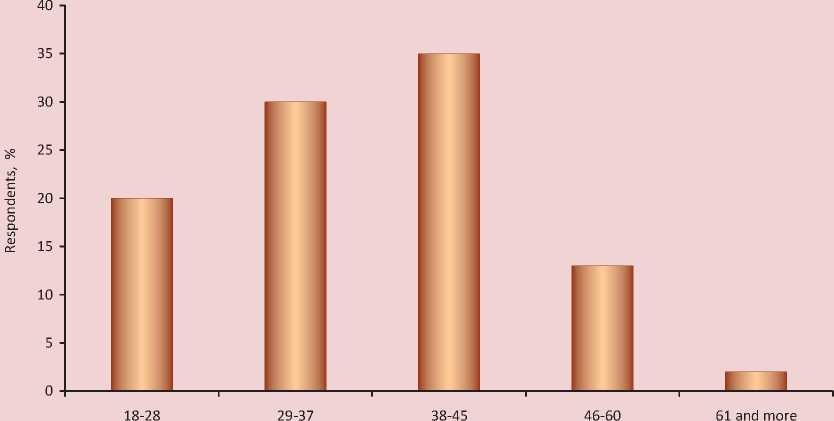
Age, years
Figure 2. The structure of consumer preferences for fillers
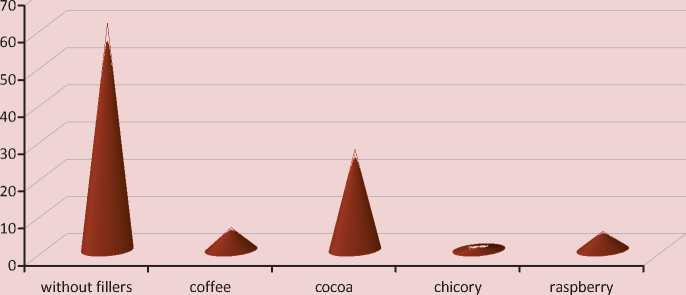
Fillers
There was the similar correlation of opinions on the addition of vegetable fat: 49% of respondents preferred vegetable fat preference, 51% of respondents preferred milk fat.
The content of preservatives in the products is an important factor in determining their quality. Respondents’ attitude towards them is presented in figure 3 .
Figure 3. The influence of the preservatives in the products on the choice of respondents: 1 – attach importance to the presence of a preservative, 2 – do not attach importance to the presence of preservative, 3 – with indifference
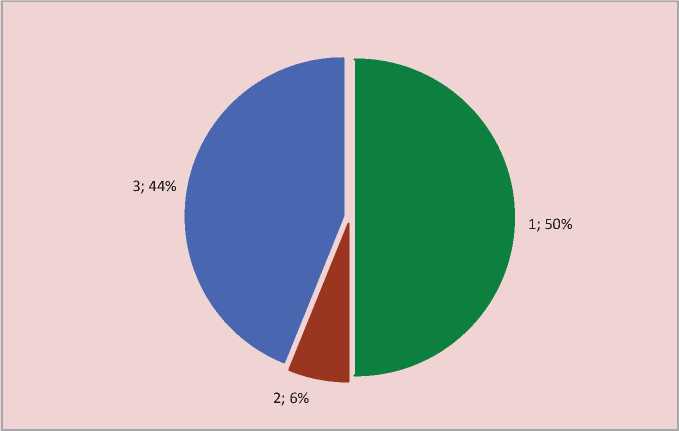
Figure 4. Packaging preferences of the respondents
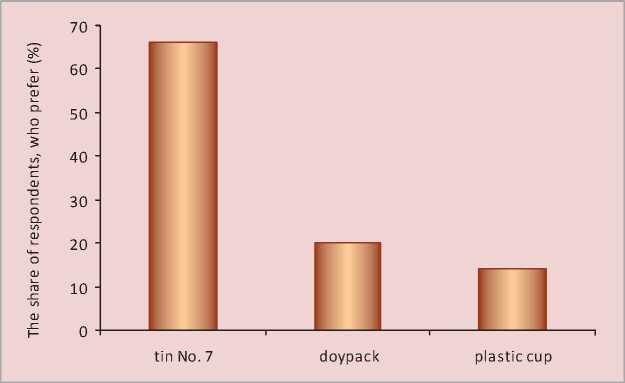
Packing has a great impact on the product competitiveness. The most popular packing includes the usual tin number 7, plastic cups and doypacks. The diagram (fig. 4) shows the preferences of the respondents. Reliability is marked as an advantage of a tin, but it is difficult to open it. Doypacks and plastic cups were recognized as the most convenient packaging.
It is very important for the producers to know how often consumers will buy their products, i.e. they want to know the size of demand for their products. The following information about the regularity of condensed sweetened milk consumption was founded during the survey (fig. 5) .
The competitiveness of a product depends not only on consumer preferences and taste,
Figure 5. The frequency of product consumption

but also on its price. The results of the survey have shown that the most reasonable price for a package of sweetened condensed milk enriched with vitamins ranged from 41 to 50 rubles.
Most consumers (72%) trust the products of Sukhonsky Dairy Plant; 27% of respondents trust the production of Glavproduct.
Thus, this survey has revealed the preferences of respondents, which allow us to make a conclusion about the characteristics of a com- petitive product that should be considered when developing new types of sweetened canned milk.
In particular, it is concluded that the milkcontaining products of natural origin, which are enriched with vitamins and which have viscous texture, as well as flavour and color corresponding to the filler, would be in demand. The cost of this product should not exceed 41 – 50 rubles.
Список литературы Increasing the competitiveness of preserved milk products on the food market
- Goroshchenko L.G. The trends in the development of dairy production in Russia. Dairy Industry. 2011. No. 4. P. 5-9.
- Labinov V.V. Dairy market: current status and forecasts. Dairy Industry. -2009. No. 3. P. 7-9.
- Labinov V.V. Dairy market: current status and prospects. Dairy Industry. -2011. No. 3. P. 26-27.
- Petrov A.N., Galstyan A.G. Production of sweetened condensed milk products. Food Industry. 2008. No. 3. P. 28-29.
- The finest hour has passed. The Russian market of canned milk and meat. Russian food and drinks. 2008. No 4. P. 88-90.
- Rybalova, T.I. Major trends in the global dairy market in the period from 2008 to 2017. Dairy Industry. 2008. No. 12. P. 11-13.
- Smirnov E.R. The 2010 World Dairy Market. Dairy Industry. No. 2. P. 5-6.

